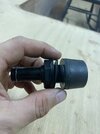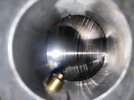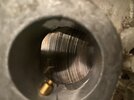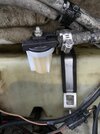mejim707
Active Member
After redoing the pop off again, and setting both MAG and PTO carbs to almost exact 35PSI I took the boat out this morning.
STARTING:
I ran it at the dock for about 30 minutes revving the engine and such then shut it down. waited 15 minutes and tried to start. It took about 3 - 4 minutes, on and off attempting at WOT to get it to fire and it did! That was actually great progress! But it's still not quite there yet. I don't feel comfortable shutting it down at a far away dock or even in the middle of the lake.
The engine starts instantly out of water and in water when cold. But after running a while then shutting off for 15 minutes it's more difficult to start in water but it does actually start now after a few minutes and some effort.
IDLE:
The idle is dead on 1400RPM in water. When sitting there in water the idle is not super smooth. It's not bad just not smooth. And low speed just putting along at 2500 RPM it seems as if the engine sputters a little. Not sure how it's supposed to be so maybe this is normal? I've never had a seadoo that was running tip top before so I have no point of reference.
ADJUSTMENTS:
I did adjust the butterflies to be in sync and low speed fuel should be dead on 1 full turn out and that's it. The oil cable / pump is also adjusted perfectly in line with the two reference marks.
PERFORMANCE:
When I hit the throttle it pops out of the hole with no issue, and runs epic at any cruising speed. At 75 - 80 % throttle I was doing a clean 40 - 45 MPH depending on waves so I know the engine is performing well. This thing feels awesome at speed, even for extended periods of time. I was running at 75% throttle for about 45 minutes straight with not a single issue flying at 40 - 45 MPH. I love it!
THOUGHTS?:
So, with all that said, what do you gurus think my next steps should be to diagnose this tough to start issue on water when warm?
As a last note, when the boat is sitting there, with the engine off, and I have the engine bay open, I can hear what sounds like water trickling in some place. There's no sign of water in the hull, no leaks at all, but I hear it! And it sounds like it's coming into the exhaust. Is water supposed to trickle into the exhaust when you're just sitting there?
Thank you all for all the help in the past and now! Much appreciated.
STARTING:
I ran it at the dock for about 30 minutes revving the engine and such then shut it down. waited 15 minutes and tried to start. It took about 3 - 4 minutes, on and off attempting at WOT to get it to fire and it did! That was actually great progress! But it's still not quite there yet. I don't feel comfortable shutting it down at a far away dock or even in the middle of the lake.
The engine starts instantly out of water and in water when cold. But after running a while then shutting off for 15 minutes it's more difficult to start in water but it does actually start now after a few minutes and some effort.
IDLE:
The idle is dead on 1400RPM in water. When sitting there in water the idle is not super smooth. It's not bad just not smooth. And low speed just putting along at 2500 RPM it seems as if the engine sputters a little. Not sure how it's supposed to be so maybe this is normal? I've never had a seadoo that was running tip top before so I have no point of reference.
ADJUSTMENTS:
I did adjust the butterflies to be in sync and low speed fuel should be dead on 1 full turn out and that's it. The oil cable / pump is also adjusted perfectly in line with the two reference marks.
PERFORMANCE:
When I hit the throttle it pops out of the hole with no issue, and runs epic at any cruising speed. At 75 - 80 % throttle I was doing a clean 40 - 45 MPH depending on waves so I know the engine is performing well. This thing feels awesome at speed, even for extended periods of time. I was running at 75% throttle for about 45 minutes straight with not a single issue flying at 40 - 45 MPH. I love it!
THOUGHTS?:
So, with all that said, what do you gurus think my next steps should be to diagnose this tough to start issue on water when warm?
As a last note, when the boat is sitting there, with the engine off, and I have the engine bay open, I can hear what sounds like water trickling in some place. There's no sign of water in the hull, no leaks at all, but I hear it! And it sounds like it's coming into the exhaust. Is water supposed to trickle into the exhaust when you're just sitting there?
Thank you all for all the help in the past and now! Much appreciated.









